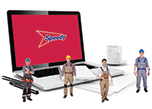
Guide to Manual Handling at Work
Manual handling refers to transporting or supporting a load by hand or bodily force. It is part of the wider lifting and handling task in the workplace.
Manual handling in the workplace can involve:
- Lifting
- Lowering
- Pushing
- Pulling
- Carrying items
It is vital that anyone conducting manual handling tasks completes manual handling training, to become familiar with regulations, risks, and how to reduce danger.
Manual handling tasks cause around 40% of all workplace injuries in the UK every year. These injuries are part of a wider group of musculoskeletal disorders (MSDs). The term ‘musculoskeletal disorders’ comprises of pain to the back, joints, and limbs.
Items don’t necessarily have to be heavy to cause issues. Poor manual handling techniques, such as bending the wrong way to lift a box with nothing in it or kicking a cardboard box out of your way, can still cause damage to a person’s legs, back or arms.
Manual handling can cause issues through:
- Heavy items
- Awkward posture
- Repetitive movement
- Lack of preparation
- Existing injuries or tweaks that are worsened
Regarding these factors, you need to establish technique, workload and whether the individual has picked up previous injuries (such as from sports or if they have underlying health issues).
Products to Help with Manual Lifting in the Workplace
Manual handling involves a lot of different tasks, as mentioned. Here at Speedy, we have a range of equipment that can help with manual handling tasks, including specialised tasks, such as:
- Imer TR225N 180° Scaffold Hoist - designed to lift and lower material to and from the ground safely
- Genie SLA10 Material Lift - portable, for indoor and outdoor lifting. Wide loads and through doorways
- Columbus HU 25-115 TS Pallet Truck - for the transportation of palletised goods and box pallets
- Armorgard RT400 Rubble Truck - for transporting and tipping a range of rubble and other aggregates
- Probst VPH150 Paving Stone Layer - for the manual laying of dense materials such as blocks and concrete. With vacuum suction
- Eichinger 1511 4Key Manhole Cover Lifter - lifts and moves manhole covers
Why is care over manual handling important?
Injuries through improper handling can harm both the handler and the business or employee.
Back injuries, for instance, can mean people can be out of work for months, unable to carry out tasks both at work and at home. Elbow or other joint injuries may mean less time away from work, and more chance of overall mobility, but can still cause issues carrying out everyday tasks such as writing or walking.
Anyone signed off work can face financial difficulty, and it also means your business is one person down. Depending on the severity of the injury, the person may face a lifetime of pain or mobility issues.
What should I do to reduce manual handling risks?
As an employer, you must protect your workers from risks of hazard, injury, and illness. All of these issues can occur when handling, lifting, carrying or moving.
According to the Management of Health and Safety at Work Regulations, you must AVOID hazardous manual lifting operations as far as practical, ASSESS the risk of injury and REDUCE the risk of injury.
Lifting and general handling should be minimised in the workplace. This may mean the use of a forklift truck or other vehicle on a construction site, or specialist materials handling equipment, to limit lifting and moving manually.
However, we are aware that in many workplaces, handling cannot be ruled out completely.
All employers should carry out a risk assessment before any work is carried out, including lifting, moving, and handling. This should establish what is needed, what needs to be done, and who will be doing what.
You need to consider:
- The individual requirements of the lifter
- The nature of the load
- Where the load will be taken (how long/far to be carried)
- Environmental conditions (such as hazards to walk around)
- Training (both a manual handling course for the individual and if there is anyone on site who will be first aid trained)
Encourage workers to report any concerns they have about their lifting tasks, such as if they feel it is too large or heavy for independent lifting, or if they have underlying pain and health issues.
This can mean somebody else is assigned the task, or you may need to take steps to adapt the job for the entire workforce.
Employees
Employees also have a duty to follow the systems put in place, inform their manager or employer of any underlying health and physical issues which may affect their ability to do their job and inform their manager or employer of any worries or concerns.
You can read about safe handling and what to ask yourself before you lift anything in our guide.
Who needs manual handling training?
Manual handling training should be made available to all in the workplace. Everyone could potentially need to lift or move something, and employers should bare this in mind. Anyone whose job it is to lift and move things day to day should definitely be required to conduct training.
This applies to construction and building staff, warehouse staff, hospital workers, office staff, kitchen workers, delivery drivers and manual labourers.
- 2024
- 2023
- December 2023 (13)
- November 2023 (10)
- October 2023 (6)
- September 2023 (10)
- August 2023 (20)
- July 2023 (21)
- June 2023 (17)
- May 2023 (17)
- April 2023 (17)
- March 2023 (14)
- February 2023 (15)
- January 2023 (7)
- 2022
- December 2022 (6)
- November 2022 (12)
- October 2022 (24)
- September 2022 (14)
- August 2022 (12)
- July 2022 (15)
- June 2022 (18)
- May 2022 (14)
- April 2022 (9)
- March 2022 (5)
- February 2022 (5)
- January 2022 (2)
- 2021
- December 2021 (7)
- November 2021 (10)
- October 2021 (1)
- September 2021 (1)
- August 2021 (3)
- July 2021 (3)
- June 2021 (4)
- May 2021 (1)
- April 2021 (1)
- March 2021 (2)
- February 2021 (1)
- January 2021 (1)
- 2020
- 2019
- 2017
- 2016
- 2014
- 2013
- 2012
- 2011


